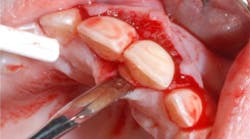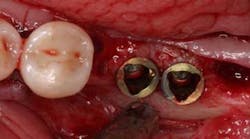High-risk patients benefit from new techniques for computer-guided implant dentistry
Journal of Oral Implantology — The added precision of computer guidance to oral implant surgery provides another leap forward in restorative dentistry. Innovative modifications of software and instrumentation are further advancing dental implant success in patients lacking adequate bone. New techniques reduce surgery time and expedite postoperative healing.
A case study in the current issue of the Journal of Oral Implantology reports on the use of computer-guided implantation in a 54-year-old patient. The patient had a very narrow ridge of bone, making drilling for implant placement difficult.
Dental implants, as introduced in the 1980s, required two surgeries and the use of a temporary denture for at least six months. In the 1990s, this restorative procedure was reduced to a single, albeit daylong, surgical process known as immediate loading. The procedure was further enhanced by the use of computer-guided techniques. The first clinical use of computer-guided techniques combined with immediate loading occurred in 2002. Dental implants can now be precisely placed in an hour or less. Dentists can use virtual planning to create a surgical template and fabricate a prosthesis for immediate placement. The patient experiences minimal postoperative pain and swelling with this less invasive procedure.
However, this technology can be limited due to local anatomical factors. To place the implant in the best position, the patient must have suitable bone at the desired implant site. Proper seating of computer-guided titanium drilling sleeves can be difficult to achieve if the patient’s crestal bone is too high or narrow. Previously, this clinical situation required opening a flap and reducing bone before placing the dental implants. The current case study, however, achieved implantation without cutting a flap or reducing the bone height, while still permitting immediate placement of the already fabricated prosthesis.
For the presented case, deeper implant site preparation was necessary for implant seating and placement of the traditional computer generated surgical guide was difficult and therefore had to be eliminated. In the virtual planning phase, a different implant length was used to reposition the guide sleeves. Drilling sequences were changed, using a starting drill that would allow deeper penetration. Osteotomes, instruments to prepare the bone, were incorporated, as was the use of an alternative implant seating mount. Despite the patient’s high risk factors for implant failure, a successful computer-guided implant was accomplished.
Read the full text of the article, “Guided Flapless Surgery With Immediate Loading for the High Narrow Ridge Without Grafting,” Journal of Oral Implantology, 38(3) 2012.
About Journal of Oral Implantology
The Journal of Oral Implantology is the official publication of the American Academy of Implant Dentistry and of the American Academy of Implant Prosthodontics. It is dedicated to providing valuable information to general dentists, oral surgeons, prosthodontists, periodontists, scientists, clinicians, laboratory owners and technicians, manufacturers, and educators. The JOI distinguishes itself as the first and oldest journal in the world devoted exclusively to implant dentistry. For more information about the journal or the American Academy of Implant Dentistry, please visit their website.






